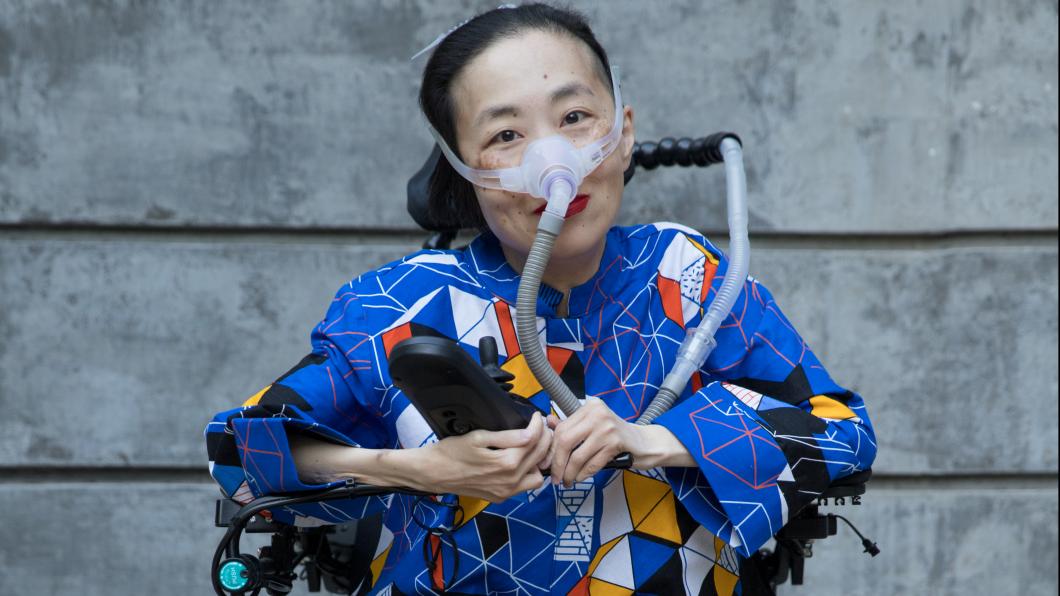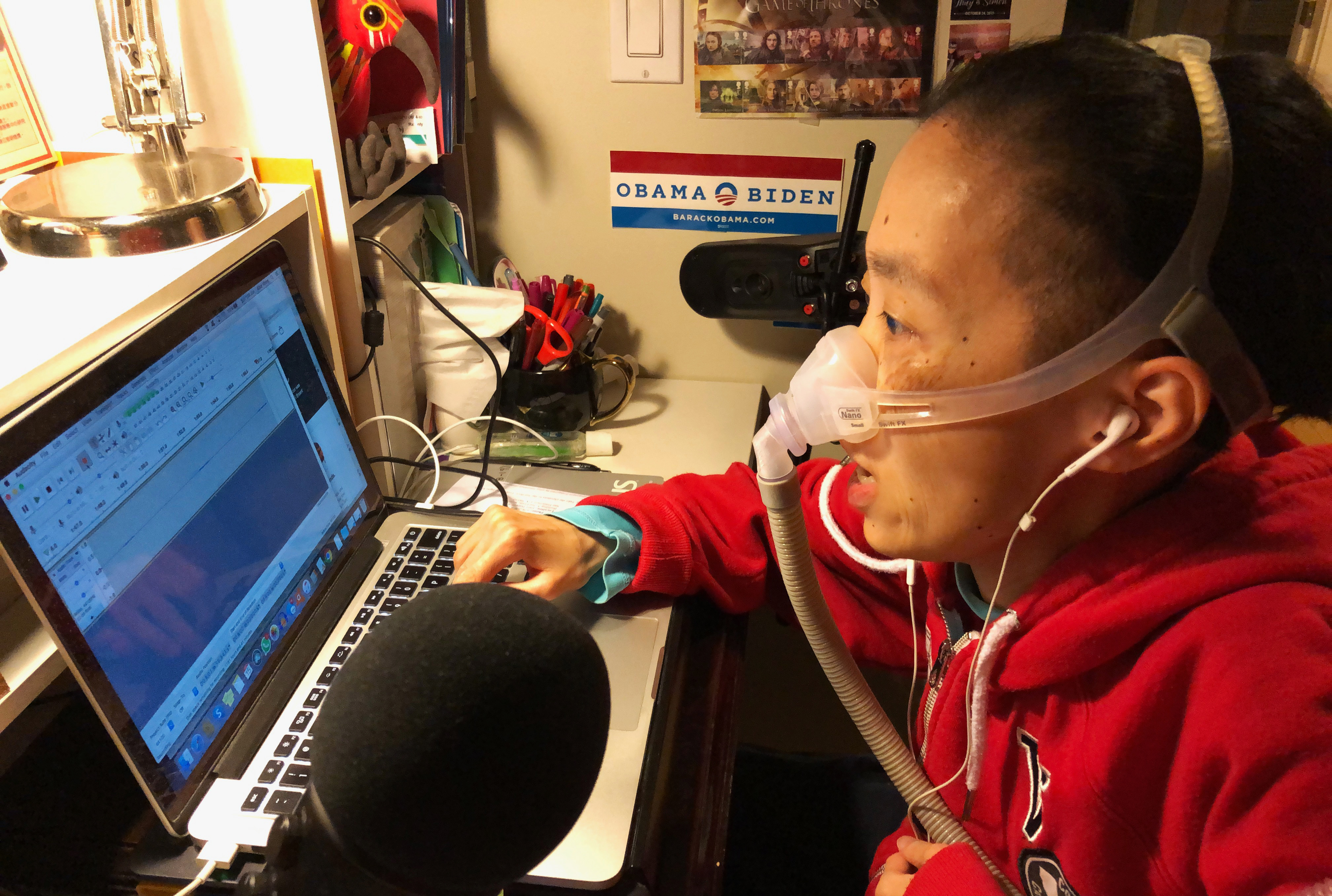
New book is Alice Wong's latest take on the 'vastness' of disability culture
By Louise Kinross
It's hard to think of someone who has done more for disability culture, community and rights than San Francisco's Alice Wong. I first heard about her through her Disability Visibility Podcast, where she interviews disabled people on everything from politics to fashion and film. I loved her logo, an image of Alice with her trademark Bi-Pap mask, purple sunglasses and red headphones. Then I learned her podcast was just one part of an online community called Disability Visibility Project (DVP).
It began in 2014 when Alice partnered with StoryCorps to encourage disabled people to record their oral histories and have them archived at the Library of Congress. Want to know about disability history and culture? Go and listen to these.
DVP has blossomed into a rich media empire where disabled people write and talk about ableism, intersectionality, culture, media, and politics. This year Time magazine named Alice one of 16 people 'fighting for a more equal America.'
Now Alice is the editor of a new anthology that launches tomorrow: Disability Visibility: First-Person Stories From the Twenty-first Century. "In this book, she has collected a staggering array of stories from writers who experience disability in vastly different ways," writes W. Kamau Bell, host of United Shades of America. "To Alice, words like ‘diversity’ and ‘intersectionality’ aren’t just buzzwords. They are marching orders." We did this interview about Alice's new book by e-mail.
BLOOM: You said as a child you didn't see yourself in images and stories around you, and when you began collecting stories about disability, you wanted to hear about everyday and diverse people. How are the stories in your book different than ones we may read elsewhere?
Alice Wong: The stories in Disability Visibility come from a wide range of sources. Some are blog posts, speeches, text transcripts from podcasts or presentations that may not have the same 'reach' as mainstream publications. I didn’t want stories from only well-known people and can say that all of the contributors have stories that are personal, political, and powerful. I also wanted to focus on stories by disabled people of colour since the default has been white for a very long time.
BLOOM: Why did you decide to structure the book in four sections: Being, Becoming, Doing and Connecting?
Alice Wong: The stories I selected couldn’t be easily categorized by subject because they varied so much. I thought structuring it in terms of actions could help the reader make connections to some of the stories that seem very different from one another.
BLOOM: You put disability rights lawyer Harriet McBryde Johnson's story about debating Princeton philosopher Peter Singer first. I thought that was brilliant, because we're confronted, immediately, with the pervasive idea that it would be better if disabled people didn't exist. Can you tell us something about three other contributors to the book?
Alice Wong: As I mentioned in the introduction of the book, I deliberately started with Harriet because her piece is a big punch in the gut depicting the very real everyday lived experiences of disability AND the larger oppressive forces that shape our lives. I ended the book with s.e. smith’s essay on the beauty and magic of being in a space completely imbued by disabled people and culture. Both of these pieces provide the reader with a social landscape about disability that captures the realness of our lives.
If I had to mention another two in addition to s.e.’s essay, I highly suggest the late Stacey Milbern’s breathtaking piece on disabled ancestors. Stacey died less than two months ago and I want everyone to appreciate her brilliance. Another excellent essay is by Jen Deerinwater on Indigenous people with chronic illness and the intersections of racism, colonialism, and ableism.
BLOOM: What was the greatest challenge of editing the book?
Alice Wong: Staying organized and on top of things! Working with 37 different contributors you have to exchange a number of edits and requests for feedback. Everyone has their own timeline but you have to give folks plenty of notice, keep them informed, and follow up when you need a response. It’s like herding a bunch of awesome cats.
BLOOM: The greatest joy?
Alice Wong: Being able to share these stories to a wider audience. I want people to learn more about each writer after reading this book!
BLOOM: I found one of the pieces about how two writers with brain injuries supported each other's work fascinating. And I loved this quote. It seems to sum up a lot of what I'm taking from the book: 'The story of disabled success has never been a story about one solitary disabled person overcoming limitations—despite the fact that’s the narrative we so often read in the media. The narrative trajectory of a disabled person’s life is necessarily webbed. We are often only as strong as our friends and family make us, only as strong as our community, only as strong as the resources and privileges we have.' Can you speak to that?
Alice Wong: A.H. Reaume’s essay is about the beauty that comes from interdependence, that it’s ok to be vulnerable and how we all have the capacity to share and support one another. American culture conflates independence with strength and many sick, older, and disabled people know there’s also strength in needing and providing help. Friendship among disabled people is a wondrous thing where we can be ourselves without having to prove anything to anyone.
BLOOM: You also produced a plain language version of the book, which is quite unusual. Can you share who edited that version, and what their objectives were?
Alice Wong: Sara Luterman is an autistic writer and journalist who knows how to write in plain language. She is the author of the plain language version. It was important to me that this book is as accessible as possible recognizing that not everyone processes information in the typical way. Naomi Ortiz, another disabled writer, created a discussion guide for any reader, educator, or book group. Both of these publications can be found on my website starting June 30th.
BLOOM: There is an incredible variety and breadth of voices in the book. The only ones I found missing were those who aren't able to easily communicate in words. You do include an AAC user, and a person with an intellectual disability, and I recall a description of someone using ASL. But I couldn't help wondering how people like my son, who doesn't speak, and isn't fluent in sign due to physical disability, will be heard in a culture that over values speech and text. I don't have an answer, but I wondered if you had any thoughts?
Alice Wong: I don’t have an answer because I look to non-speaking people to lead the way on this. They should be centred on telling the world how to go beyond speech and text. Everyone has a story and should tell it in the way that is natural for them. It is up to all of us to understand and communicate with people in a variety of ways. There are many non-speaking people who use technology or other forms of assistance who are incredibly prolific and I hope more people have access to what they need so they can express themselves as authentically as possible. Communication First is an organization I'm following to educate myself.
BLOOM: The book's launch is incredibly timely, given the pandemic and how we see it disproportionately impact marginalized groups, including disabled and racialized people. What do you hope people take from the book?
Alice Wong: I hope people find connection and joy from the book and that it excites them about the vastness of our culture and community. Disability Visibility is just a small sample of what’s out there and I want to encourage people to keep learning and discovering.
